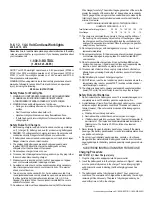
2
Shift Work
Use the following techniques to adjust your circadian rhythm to your work shift.
Beginning a Night-shift Schedule
Many people benefit from receiving a 30-minute burst of light before work and then 15 minutes of light
every three hours during work. This not only increases alertness and performance, but shifts the body clock
as well. Within three days, your body clock will have changed to a night-shift schedule. Taking time-release
melatonin upon arriving home after work may help accelerate the shifting of your body clock. After the
second day, melatonin should not be necessary, and your body clock will have adapted to the new schedule.
Note: When coming off of night shift work, it is important to wear sunglasses and avoid any bright light
while going home. You should go to sleep as soon as possible after leaving work.
Returning to a Day-shift Schedule
On the day your night shift ends, continue to wear sunglasses and avoid bright light in the morning
hours. Do not take melatonin in the morning. Use your goLITE® for 30 minutes at about midday. On
the first day, you may take an afternoon nap if you are having trouble staying awake. Go to bed at your
normal evening bedtime.
You may wish to use time-release melatonin in the early evening (about 7:00 PM) to accelerate your body
clock to a normal schedule. You may want to wait a few hours after waking in the afternoon or evening
before taking melatonin as it may cause drowsiness. This routine should only need to be repeated once or
twice before you achieve a normal sleep/wake schedule.
After the first day, you should use the goLITE® each morning as needed for approximately 15–30 minutes.
For more detailed information about using your goLITE® to help adapt to shift work schedules, visit
www.ApolloHealth.com.
Jet Lag
Rapidly traveling across several time zones creates disharmony between your internal body clock and the
new external time. This not only causes problems with sleeping, but influences mood and energy as well.
Because specialized light is effective for shifting circadian rhythms, your goLITE® can quickly adjust your
rhythm to the new time zone. The best strategy for combating jet lag is to shift your body clock a day or
two before leaving.
Traveling East
Use your goLITE® in the morning two to three days before leaving. The number of time zones traveled
corresponds to the hours needed to shift. On the first day, wake up an hour early and use the goLITE® for
30–45 minutes. This will shift your body clock up to three time zones. The next day(s) you need to awaken
a couple of hours earlier and repeat this process. Taking time-released melatonin in the early evening or
late afternoon can also help accelerate this shift. You should adjust your sleep schedule as described each
day. Upon arrival, wear sunglasses to avoid any sunlight before 10:00 AM. When returning, use your
goLITE® in the evening for a few nights and avoid any morning light (see Traveling West).
Traveling West
Use your goLITE® in the evening for 30–40 minutes a few days before leaving, and use the goLITE® a
couple of hours later each successive day. Each day you use the goLITE®, you shift your internal time up
to three hours, and you can increase this shift up to six hours per day by taking melatonin in the morn-
ing. When returning, avoid any bright afternoon and evening light and be sure to use your goLITE® in
the morning for a few days (see Traveling East).
S
u
g
g
e
st
e
d
U
sa
g
e
F
o
r
Yo
u
r
g
o
LI
T
E
®
S
u
g
g
e
st
e
d
U
sa
g
e
F
o
r Y
o
u
r g
o
LI
T
E
®





























